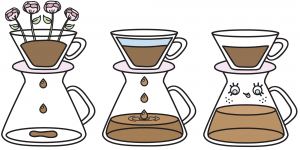Time
The Brew Cycle

Illustration of the three phases of the brew cycle
A recipe designer considers three principal phases when planning for a percolation brew method: blooming, dilution, and drawdown. For consistency between batches, the duration of each phase should be tightly controlled. We use the term contact time to describe the time elapsed from the moment the water is first added until the final drips percolate out the bottom of the filter paper. It is important to note that, due to the nature of gravity-fed percolation, a barista can control the delivery time only up to the end of the dilution phase. The drawdown time is a function of the grind setting (see Lesson 2.04) and the calibration of the filter paper (see Lesson 4.04).
Planning the Delivery Time on Batch Brewers
The interaction of time and flow rate on almost all batch-brewing machines is very basic. No batch brewing machine on the market provides variable flow rate technology similar to what we see on some modern espresso machines. This explains, in part, why batch-brewing machines usually cost around one-quarter the price of an espresso machine. It also explains why they tend to be reliable and simple to maintain. In batch-brewing machines, the flow rate of water is fixed; when you attempt to alter the amount of time it takes for water to be introduced to the slurry, the machine divides your total brew volume and your desired contact time and divides the delivery of the water into a number of pulses.
Machines That Allow You to Control Delivery Time
With most machines you are able to specify the amount of water you want to add and the amount of time you want the process to take. Some machines also allow you to indicate the number of pulses in which the water will be delivered to the filter basket. We recommend you use a minimum of six pulses of water across the brew cycle.